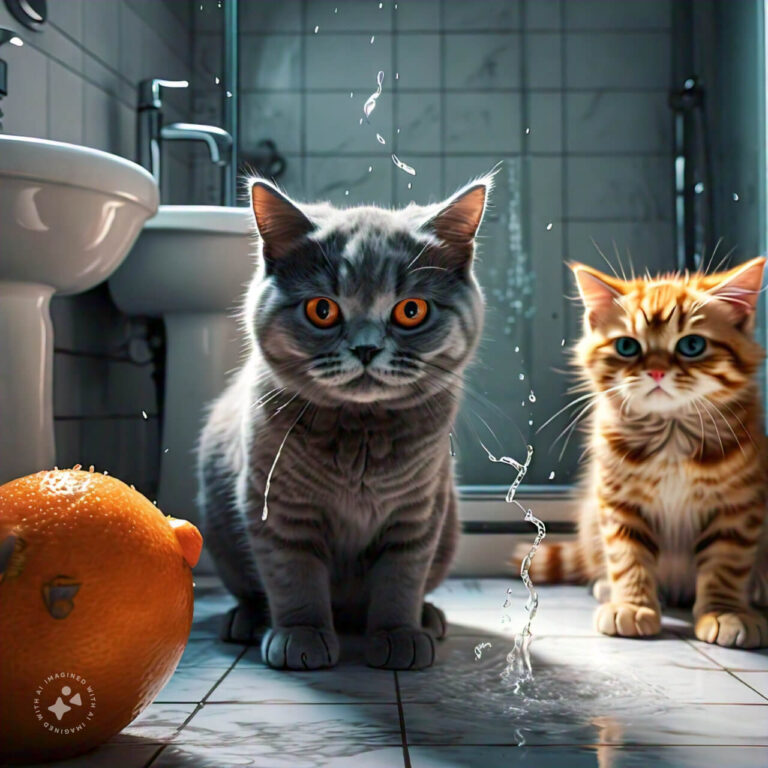Why My Cats Eyes Are Red – veterinarian.pk
Understanding the Causes Behind Red Eyes in Cats
Red eyes in cats can be a sign of various underlying issues, ranging from minor irritations to serious health conditions. It’s important for cat owners to recognize the symptoms and understand the potential causes so they can seek appropriate care for their feline friends.
Common Causes of Red Eyes in Cats
Allergies: Cats, like humans, can suffer from allergies that cause inflammation in the eyes. Common allergens include pollen, mold, dust mites, and certain foods. Allergic reactions can lead to redness, itching, and watery eyes.
Conjunctivitis: Also known as pink eye, conjunctivitis is an inflammation of the membrane covering the inside of the eyelids and the white part of the eye. It can be caused by bacterial or viral infections, and it’s highly contagious among cats.
Injury: Trauma to the eye, such as scratches from fights with other animals or accidental bumps against objects, can lead to redness and swelling.
Foreign Objects: Cats are curious creatures, and they often explore areas where they might get small particles like dust, sand, or plant material in their eyes, causing irritation.
Serious Health Conditions
Glaucoma: This is a serious condition in which increased pressure within the eye causes redness, pain, and potentially, loss of vision. Glaucoma requires immediate veterinary attention.
Uveitis: Uveitis is inflammation of the uveal tract of the eye, which includes the iris, ciliary body, and choroid. It can be caused by infectious diseases, immune-mediated diseases, or cancer.
Symptoms to Watch For
In addition to redness, symptoms that may accompany red eyes in cats include:
- Squinting or excessive blinking
- Discharge from the eye, which may be clear, white, yellow, or green
- Swelling around the eyes
- Pawing at the eyes or rubbing the face against furniture or the floor
- Changes in the eye’s appearance, such as a cloudy or dull look
When to Visit the Vet
If you notice any of the above symptoms, it’s important to consult with a veterinarian as soon as possible. Early diagnosis and treatment can prevent more serious complications and help keep your cat comfortable.
Understanding the causes and symptoms of red eyes in cats is crucial for providing the best care for your pet. Regular check-ups and keeping an eye on your cat’s eye health can help ensure that they lead a happy and healthy life.
Common Health Issues Associated with Red Eyes in Felines

Red eyes in cats can be an alarming symptom for any pet owner. This condition can indicate a variety of health issues, ranging from minor irritations to serious diseases. Understanding the potential causes and when to seek veterinary assistance is crucial for maintaining your cat’s eye health and overall well-being.
Conjunctivitis: The Leading Cause of Red Eyes
Conjunctivitis, or pink eye, is one of the most common causes of red eyes in cats. This inflammation of the conjunctiva, the delicate membrane covering the eye and inner eyelids, can be triggered by infections, allergies, or irritants like dust and smoke. Symptoms include redness, swelling, and often a discharge that can be clear or colored. Treatment typically involves cleaning the eye and administering prescribed eye drops or ointments to reduce inflammation and address infections.
Corneal Disorders: Scratches and Ulcers
The cornea, the transparent front part of the eye, can also suffer from various issues that cause redness. Corneal ulcers are serious and can occur from scratches, chemicals, or infections, leading to painful inflammation and redness. Immediate veterinary care is essential to prevent complications, including blindness. Treatment may include antibiotics and protective collars to prevent your cat from rubbing its eyes.
Uveitis: A Deeper Problem
Uveitis is the inflammation of the uveal tract comprising the iris, ciliary body, and choroid inside the eye. It can cause redness and is often associated with systemic infections, immune diseases, or trauma. Uveitis can be very painful and may lead to serious issues like glaucoma or cataracts if untreated. Depending on the underlying cause, treatment may involve anti-inflammatory drugs and specific therapies targeting the root cause.
Glaucoma: A Critical Condition
Glaucoma is an increase in the pressure within the eye that is extremely painful and can lead to permanent damage to the optic nerve. Symptoms include a red appearance in the eye, often combined with cloudiness and visibly enlarged eyes. Glaucoma requires urgent veterinary treatment to relieve pressure and preserve vision, typically involving medication and possibly surgery.
Preventive Measures and Early Detection
Regular veterinary check-ups can help detect and treat eye conditions before they become serious. Keeping your cat’s living environment clean and free from irritants, and monitoring for any signs of eye discomfort, can also help maintain healthy eyes.
Conclusion: Pay Attention to Eye Health
If your cat’s eyes appear red, do not wait to seek veterinary care. Early diagnosis and appropriate treatment are key to managing eye health issues in cats, ensuring they lead comfortable and healthy lives.
When to Seek Veterinary Care for Your Cat’s Red Eyes
Red eyes in cats can be a sign of various underlying health issues, some of which require immediate veterinary attention. As a cat owner, it’s crucial to recognize when red eyes are just a minor irritation and when they indicate something more serious. This article will guide you through the signs to watch for, the potential causes, and when it’s essential to visit your vet.
Recognizing the Signs: When Red Eyes Are More Than Just an Irritation
Red eyes in your cat can be caused by a variety of issues, ranging from simple allergies to serious health conditions. It’s important to observe not just the redness, but also any accompanying symptoms such as discharge, squinting, or changes in behavior. These symptoms can help differentiate between a temporary irritation and a potential emergency.
Common Causes of Red Eyes in Cats
Before you decide to visit the vet, understanding what could be causing your cat’s red eyes might help in assessing the urgency of the situation. Common causes include:
- Conjunctivitis: This is the inflammation of the tissue covering the eye and the inside of the eyelids and is one of the most common causes of red eyes in cats.
- Injuries: Physical injuries from fights, accidents, or even scratches can cause redness and swelling.
- Foreign Objects: Dust, dirt, or other small particles can get trapped in your cat’s eyes, causing irritation.
- Allergies: Allergens like pollen, smoke, or chemical fumes can lead to red and itchy eyes.
- Diseases: More serious conditions like glaucoma, uveitis, or corneal ulcers can also cause red eyes and might require urgent care.
When to Visit Your Veterinarian
Knowing when to seek professional help is key to ensuring your cat’s health and wellbeing. Here are some scenarios when you should definitely consider a vet visit:
- Persistent Redness: If the redness does not improve or worsens over 24 to 48 hours.
- Accompanied by Discharge: Eye discharge that is yellow, green, or bloody is a sign of infection.
- Behavioral Changes: If your cat is rubbing their eye frequently, showing sensitivity to light, or seems more withdrawn or aggressive, it’s time to consult your vet.
- Signs of Pain: Squinting, increased blinking, or apparent discomfort are indicators that something more serious may be affecting your cat’s eyes.
Preventive Measures and Home Care
While some situations require professional care, there are preventive measures you can take to help maintain your cat’s eye health:
- Regular Cleaning: Use a soft, damp cloth to gently wipe away any dirt or residues from around the eyes.
- Protect from Irritants: Try to keep your home free from excessive dust and smoke and be mindful of exposing your cat to potential allergens.
- Routine Check-ups: Regular veterinary visits can help catch and treat eye issues before they become serious.
Conclusion
Red eyes in cats can sometimes be a minor issue, but they can also signal something more serious. As a responsible pet owner, your ability to recognize the signs and understand when to seek help can make a significant difference in your cat’s quality of life and health. Always err on the side of caution and consult your vet when in doubt.
Home Care and Prevention Tips for Red Eyes in Cats
Caring for a cat with red eyes can be concerning for any pet owner. This article offers detailed guidance on how to manage and prevent red eyes in cats, ensuring they remain comfortable and healthy.
Understanding Red Eyes in Cats
Before diving into home care and prevention, it’s essential to understand what might cause red eyes in cats. Redness in a cat’s eyes can be a sign of several conditions, ranging from minor irritants like dust or allergies, to more serious issues such as infections or glaucoma. Recognizing the underlying cause is crucial as it determines the approach to care and prevention.
Initial Home Care Steps
If you notice your cat’s eyes are mildly red without severe pain, discharge, or vision changes, some initial home care steps can be helpful:
- Keep the Eyes Clean: Gently wipe your cat’s eyes with a damp, soft cloth to remove any dirt or discharge. Use a different part of the cloth for each eye to prevent cross-contamination.
- Reduce Eye Irritants: Minimize your cat’s exposure to irritants like smoke, dust, and chemical fumes. Ensuring your home is well-ventilated and free of strong odors can help reduce eye irritation.
When to Consult a Veterinarian
It’s important to monitor the condition closely. If redness persists or is accompanied by other symptoms such as squinting, swelling, excessive tearing, or behavioral changes, it’s time to consult your veterinarian. They can provide a proper diagnosis and treatment plan which might include medications such as eye drops or ointments.
Ongoing Prevention Tips
Preventing red eyes in cats involves routine care and attention to their living environment:
- Regular Check-Ups: Regular veterinary check-ups can catch and address eye issues before they become serious.
- Maintain Good Hygiene: Regularly cleaning your cat’s bedding and play areas helps minimize the risk of eye irritants.
- Proper Grooming: Especially for breeds with longer fur, keeping the fur around the eyes trimmed can prevent it from irritating the eyes.
Understanding Your Cat’s Health
Finally, understanding your cat’s health and behavior is key to preventing eye issues. Pay attention to their behavior changes and be proactive in seeking veterinary advice when something seems off. Regular care and preventive measures can go a long way in keeping your cat’s eyes healthy.
By following these tips, you can help manage and prevent red eyes in your cat, contributing to their overall well-being and happiness.






